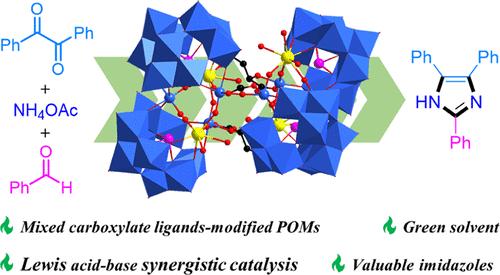桥接四-Pr3+-封装锑钨酸盐的混合羧酸配体:用于咪唑类化合物合成的合成、结构和催化活性
IF 4.7
2区 化学
Q1 CHEMISTRY, INORGANIC & NUCLEAR
引用次数: 0
摘要
通过单锅组装反应合成了以有机羧酸为桥的多核含镨锑钨酸盐 [Pr4(H2O)10W6O13(mal)2(OAc)(B-α-SbW9O33)4]21-(Pr-1,mal = 苹果酸阴离子,OAc = 乙酸阴离子),并对其进行了结构表征。Pr-1 由四个[B-α-SbW9O33]9-片段组成,它们通过 24 个 μ2-O 原子被一个有机-无机混合中心[Pr4(H2O)10W6O13(mal)2(OAc)]15+ 簇核融合在一起。值得注意的是,该中心簇包含前所未有的十核 Pr4(H2O)10W6O13,由两种类型的羧酸配体共同装饰。这种含稀土的锑钨酸盐与混合有机羧酸配体的结合在 POMs 化学中非常罕见。在涉及苯偶酰、醛和 NH4OAc 的环缩合反应中,Pr-1 表现出卓越的催化活性。使用 iPrOH 作为绿色溶剂合成了一系列 2,4,5-三取代咪唑,收率极高。本文章由计算机程序翻译,如有差异,请以英文原文为准。

Mixed Carboxylate Ligands Bridging Tetra-Pr3+-Encapsulated Antimonotungstate: Syntheses, Structure, and Catalytic Activity for Imidazoles Synthesis
Multinuclear Pr-containing antimonotungstate [Pr4(H2O)10W6O13(mal)2(OAc)(B-α-SbW9O33)4]21– (Pr-1, mal = malate anion, OAc = acetate anion), bridged by organic carboxylic acid, was synthesized through a one-pot assembly reaction and structurally characterized. Pr-1 is composed of four [B-α-SbW9O33]9– fragments fused together by an organic–inorganic hybrid central [Pr4(H2O)10W6O13(mal)2(OAc)]15+ cluster core through 24 μ2-O atoms. Notably, the central cluster comprises unprecedented decanuclear Pr4(H2O)10W6O13 jointly decorated by two types of carboxylic acid ligands. This integration of rare earth-containing antimonotungstate with mixed organic carboxylate ligands is very rare in POMs chemistry. Pr-1 exhibits excellent catalytic activity in the cyclo-condensation reaction involving benzil, aldehyde, and NH4OAc. A series of 2,4,5-trisubstituted imidazoles were synthesized in remarkable yields using iPrOH as a green solvent.
求助全文
通过发布文献求助,成功后即可免费获取论文全文。
去求助
来源期刊

Inorganic Chemistry
化学-无机化学与核化学
CiteScore
7.60
自引率
13.00%
发文量
1960
审稿时长
1.9 months
期刊介绍:
Inorganic Chemistry publishes fundamental studies in all phases of inorganic chemistry. Coverage includes experimental and theoretical reports on quantitative studies of structure and thermodynamics, kinetics, mechanisms of inorganic reactions, bioinorganic chemistry, and relevant aspects of organometallic chemistry, solid-state phenomena, and chemical bonding theory. Emphasis is placed on the synthesis, structure, thermodynamics, reactivity, spectroscopy, and bonding properties of significant new and known compounds.
 求助内容:
求助内容: 应助结果提醒方式:
应助结果提醒方式:


